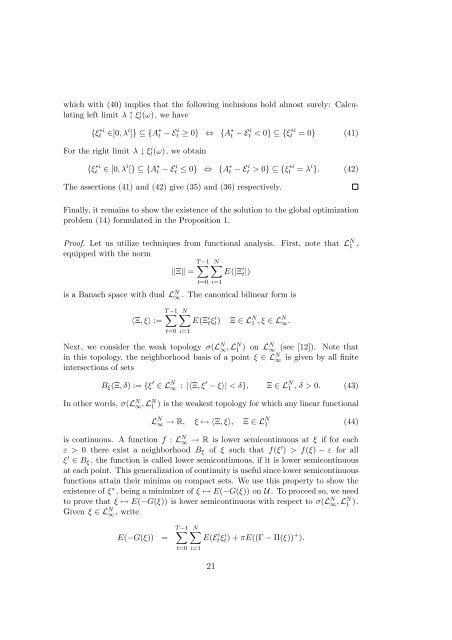A quantitative approach to carbon price risk modeling - CiteSeerX
A quantitative approach to carbon price risk modeling - CiteSeerX
A quantitative approach to carbon price risk modeling - CiteSeerX
Create successful ePaper yourself
Turn your PDF publications into a flip-book with our unique Google optimized e-Paper software.
which with (40) implies that the following inclusions hold almost surely: Calculating<br />
left limit λ ↑ ξ i t(ω), we have<br />
{ξ ∗i<br />
t ∈]0, λ i ]} ⊆ {A ∗ t − E i t ≥ 0} ⇔ {A ∗ t − E i t < 0} ⊆ {ξ ∗i<br />
t = 0} (41)<br />
For the right limit λ ↓ ξ i t(ω), we obtain<br />
{ξ ∗i<br />
t ∈ [0, λ i [} ⊆ {A ∗ t − E i t ≤ 0} ⇔ {A ∗ t − E i t > 0} ⊆ {ξ ∗i<br />
t = λ i }. (42)<br />
The assertions (41) and (42) give (35) and (36) respectively.<br />
Finally, it remains <strong>to</strong> show the existence of the solution <strong>to</strong> the global optimization<br />
problem (14) formulated in the Proposition 1.<br />
Proof. Let us utilize techniques from functional analysis. First, note that L N 1 ,<br />
equipped with the norm<br />
T∑<br />
−1 N∑<br />
‖Ξ‖ = E(|Ξ i t|)<br />
t=0 i=1<br />
is a Banach space with dual L N ∞ . The canonical bilinear form is<br />
〈Ξ, ξ〉 :=<br />
T∑<br />
−1<br />
t=0 i=1<br />
N∑<br />
E(Ξ i tξt) i Ξ ∈ L N 1 , ξ ∈ L N ∞.<br />
Next, we consider the weak <strong>to</strong>pology σ(L N ∞, L N 1 ) on LN ∞ (see [12]). Note that<br />
in this <strong>to</strong>pology, the neighborhood basis of a point ξ ∈ L N ∞ is given by all finite<br />
intersections of sets<br />
B ξ (Ξ, δ) := {ξ ′ ∈ L N ∞ : |〈Ξ, ξ ′ − ξ〉| < δ}, Ξ ∈ L N 1 , δ > 0. (43)<br />
In other words, σ(L N ∞, L N 1 ) is the weakest <strong>to</strong>pology for which any linear functional<br />
L N ∞ → R, ξ ↦→ 〈Ξ, ξ〉, Ξ ∈ L N 1 (44)<br />
is continuous. A function f : L N ∞ → R is lower semicontinuous at ξ if for each<br />
ε > 0 there exist a neighborhood B ξ of ξ such that f(ξ ′ ) > f(ξ) − ε for all<br />
ξ ′ ∈ B ξ , the function is called lower semicontinuous, if it is lower semicontinuous<br />
at each point. This generalization of continuity is useful since lower semicontinuous<br />
functions attain their minima on compact sets. We use this property <strong>to</strong> show the<br />
existence of ξ ∗ , being a minimizer of ξ ↦→ E(−G(ξ)) on U . To proceed so, we need<br />
<strong>to</strong> prove that ξ ↦→ E(−G(ξ)) is lower semicontinuous with respect <strong>to</strong> σ(L N ∞, L N 1 ).<br />
Given ξ ∈ L N ∞ , write<br />
E(−G(ξ)) =<br />
T∑<br />
−1<br />
t=0 i=1<br />
N∑<br />
E(Etξ i t) i + πE((Γ − Π(ξ)) + ).<br />
21
















